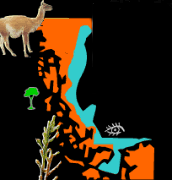
Welcome to the Aonikenk Region. Here you will find interesting information about this Chilean Indigenous People, also denominated Tewelche People. The region contains four main subjects: People (History, Social Organization, environment), Language (Gramma, Vocabulary), Customs (Spiritual World, Rituals, Mythology) and Art. Use the Interactive Map to take an animated tour of this people´s region. The teachers and students will find contents (texts and images) that be able for Printing.
There is also a Resources section in which you will find a virtual Library with Dictionaries, Texts, Books and a complete Links Directory. In addition you could listen to music or watch documentaries in our Videos, Music and Storytelling sections. Finally if you have a question relating to something other than one of these topics, you can use our Search Engine or the Site Map or write to us through the Contact form. You are cordially invited invited to Subscribe our monthly Newsletter to be informed about the site and our Chilean Indigenous Cultures news.
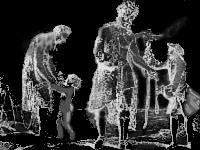
Besides their impressing stature, the Aonikenk had a amazing developed thorax. Their backs were wide and their legs were strong, features that helped them in hunting.
Women were stoutly built, with wide hips, and well proportioned. Some authors suggest that their outstanding white teeth was due to the chewing of the dark fruit of the maqui or molle, a shrub whose sap was used to make incense.
The Aonikenk's adaptation to the harsh climate and weather conditions depended on their physical tributes, on their education, and on a diet that reinforced their defenses. Early in their lives they were trained in withstanding the extreme cold.
As nomad hunters adapted to the Austral climate's harsh conditions they were physically strong and resistant. To keep their body temperature, their organism slowly eliminated the fat, having a different metabolism from contemporary people.
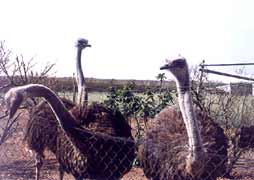
Along with the rhythmic sound of drums, flutes, musical bows and Aonikenk songs, the Ostrich Dance began.
The men who participated in the ceremony came out in a line from under a tarp.
With their bodies covered with animal skins and wearing ostrich feathers on their heads, they started walking around the fire, closing in until touching each other, and then backing up with movements that imitated the ostrich and guanaco.
Collective songs and shouts conjured up the powers and forces of evil.
The rhythm of the dance rose until they were transformed into hunted animals, the men shedding their animal skins and showing off their strong painted bodies.
They danced only with a belt made of ostrich feathers, seashells and bird beaks.
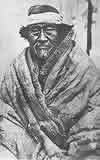
The Aonikenks believed that the old people were reincarnated into children. When a young person died, his or her soul wandered with no destiny, prisoner on earth, until completing the necessary time to grow old.
Due to this animist worldview, they buried their dead with personal objects, weapons and food. They believed that, to reach the other world, the dead would ride their mares, thus, upon their death, their animals were sacrificed.
The deceased person was introduce by their relatives into a quillango or guanaco cape, along with his or her silver objects and favorite weapons. It was then sealed, sewing the edges together. The person was buried in the fetal position, facing east and covered with heavy rocks.
The Aonikenk preferred to bury their dead far away from the community, on the hilltops or tchengue.
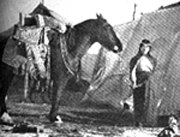
Although the Aonikenk were not exterminated like their neighbors, the Selk´nam people, they suffered a process of acculturation and the loss of their original culture.
As time passed, their spiritual world and aspects of daily life fused with the catholic religion and the culture of the colonizers. alcohol and contagious sickness, such as small pox, chicken pox and syphilis, became their most deadly enemies.
Chroniclers described a nation whose members were:
« Of good physical semblance, robust complexion, tall, healthy, and even agreeable... They wear animal skins, with the fur turned inwards... They adorn themselves and their horses... they are not ferocious and they may even be friendly.»
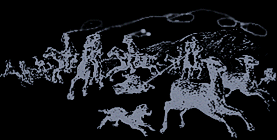
The boleadora, the spear, and although less used, the bow and arrow, were the original weapons of the Aonikenk.
For defense and hunting they used the boleadora.
This weapon was made by two stones, about the size of an egg, covered with leather and connected with a rope made of guanaco or ñandu (ostrich) tendons. In hunting, it was swung in a circle over the head and then tossed towards the legs of the animal to be catched.
There were three types of boleadoras: the chumé, yachiko, and the lost ball. The chumé had two balls and was made especially for hunting the ñandu (ostrich).
The yachiko boleadora had three stones and was used to hunt guanacos.
The lost ball was a type of sling in which the stone was not recuperated.
With the arrival of the white man, fire arms and horses were added to their culture.
| Language | ||
|
Vocabulary: Stopping, place: Aike, aiken River Place: (kon).Kon-aiken Flat hilltop: Chokeken Young guanaco (chulengo): Chetjen House, tarp, shelter: Kau Fur cape: Kai Flower petal: Kosp Vincha, ribbon worn on the head: Kochel Waistband: Guaten Blanket woven on a loom: Uendeunk Hill: Legue Date: Yeut Guanaco Eye: Shotel Good spirit: Otil nau |
Colors pink: Arantek white: Eorrenk red: Kapenke blue: Makotemk black: Pol yellow: Uaitenk green: Jestateltenk
Kosp kapenke Kosp eorrenk Kosp jestateltenk Kosp arantek Kosp uaitenk Kosp makotemk |
      |
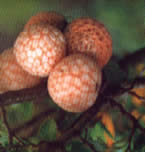
Aonikasih, the Aonikenk language, it is related to the Selk´nam language, both belonging to the Tshon linguistic branch, which is a different group than that of the rest of the South American hunter-gatherers. (According to Roberto Lehmann-Nistche).
The Aonikaish is composed of approximately 25 basic sounds, six of which are similar to the five Spanish vowels, plus one that is similar to the German ö.
The scholar Spegazzini (1884) describes Aonikaish as follows: "They speak with a very thick voice, vibrating the consonants, very softly, as if they were tired; the throat is used more, as if they were ventriloquists; there are few vowels and only the first syllables may be determined for sure and written, the rest are unintelligible or semi-mute".
For a speaker of this tongue, as the explorer Lista was, the Aonikaish not only had a unique voice for every natural object, it also expresses abstract ideas of a superior order.
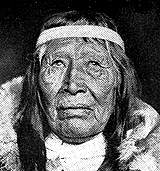
The Aonikenks believed that the old people were reincarnated into children. When a young person died, his or her soul wandered with no destiny, prisoner on earth, until completing the necessary time to grow old.
Due to this animist worldview, they buried their dead with personal objects, weapons and food. They believed that, to reach the other world, the dead would ride their mares, thus, upon their death, their animals were sacrificed.
The deceased person was introduce by their relatives into a quillango or guanaco cape, along with his or her silver objects and favorite weapons. It was then sealed, sewing the edges together. The person was buried in the fetal position, facing east and covered with heavy rocks.
The Aonikenk preferred to bury their dead far away from the community, on the hilltops or tchengue.
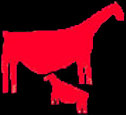
Each transition in the life cycle of the Aonikenk people was celebrated with a passage rite.
During gestation, to avoid sexual contact, the pregnant woman was separated from her husband: it was believed that semen enlarged the fetus, making labor more difficult. She then ate dry meat, avoiding liquids as much as possible. Her mother and grandmother assisted the woman in the birthing process.
The newborn was painted white, and then was named based on its physical features, place of birth, or a dead family member. At the age of four, children attended the Earring Ceremony; girls had both ears perforated and the boys had only one. A needle and horsehair were the instruments used for piercing.
At the end of the ritual a mare was sacrificed, while men danced the Ostrich Dance.
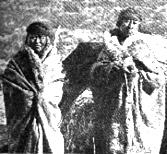
Virginity was valued, for which reason young women were taught not to have sexual relations before marriage.
The ceremony included the sacrifice of horses and dances. However, for these occasions, dogs were not fed with meat because it was considered a bad omen.
Before the beginning of the married life, the bride was initiated in the Pretty House ceremony.
Other common ritual practices included shedding blood to propiciate the spirits incarnated in nature. Another ceremony consisting in prayers to the new moon, and in dancing with their ancestral spirits in an emotional event that lasted long into the cold Patagonian night.